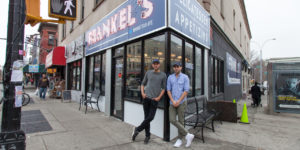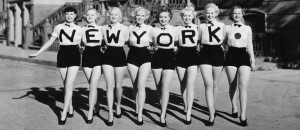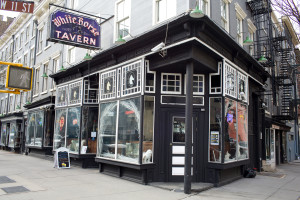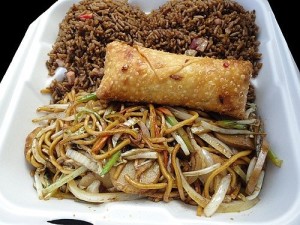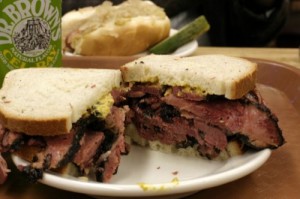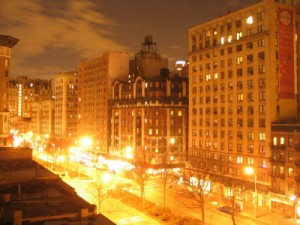Here’s some New York nostalgia: In HG’s younger New York days, Broadway (between 42nd and 57th Streets) was one of the great eating thoroughfares. HG has written memories of that Broadway (When The Great White Way Was Appetizing and The Roast Beef Sandwiches of YesteryearR). Just off Broadway, on Seventh Avenue, was Heartburn Heaven–the Stage and Carnegie Delicatessens, pastrami purveyors. And, there was the Brass Rail and its fabulous “French Dip” roast beef sandwiches. Sadly, all are gone and so has old fashioned New York, Jewish-influenced restaurant cooking. Turf, Jack Dempsey’s and Lindy’s served sublime cheesecake. Now, if you want traditional high cal New York cheesecake you’ve got to to Brooklyn and Junior’s on Flatbush Avenue. And breaking with the trend, Frankel’s, a new Jewish-style appetizing and deli, has opened up in Greenpoint. Yes, Brooklyn is keeping some of those old time tastes alive.
Broadway
January 16th, 2017 § 0 comments § permalink
Nostalgia
February 28th, 2016 § 1 comment § permalink
Ah, nostalgia. Sentimental memories of yesteryear are bittersweet. HG is nostalgic about the New York HG left many decades ago. Cheap rents on the Upper West Side. Even cheaper rents in Greenwich Village and Chelsea. Mom and Pop stores everywhere. Friendly greetings. Shopkeepers who would always cash a check in the days before ATM’s. All wiped out by the chains and high priced, high rise condos. “Co-op conversions” destroyed the distinguished old apartment houses where artists and intellectuals paid affordable rents. Dining out is a questionable experience (except, of course, at Daughter Victoria’s four restaurants–Rosie’s, Cookshop, Vic’s, Hundred Acres— where her husband, Marc Meyer, is the supervising chef). Everything in most restaurants is fancy, “creative” and centered around kale, small plates and expensive wine. Cheap meals? Fuhgeddabout it!! The Automat with its good coffee and splendid casseroles is gone. So is serviceable Bickford’s. There are still a number of Jewish pastrami heavens. All lousy. Even Katz’s and Carnegie. Sadly, the Jewish “dairy” restaurants are almost all gone, There are a few left. B & H at 127 Second Avenue maintains the old traditions. For those unfamiliar with the term, a Jewish “dairy” restaurant serves fish, vegetables, dairy products. No meat or meat products. The two great New York dairy restaurants were Ratner’s (on Delancey) and Rappaport’s (on Second Avenue). What did they serve? Herring in an infinite variety,. Gefilte fish. Borscht. Schav. Pirogen. Blintzes. Noodles with butter and pot cheese. Scores of smoked fish, tuna and sardine salads. HG is only, scratching the surface. Uptown on the Upper West Side there was the Paramount Famous on W. 72nd Street and the fancy Steinberg’s on Broadway in the 80’s. There were many other good dairy eateries in The Bronx and Brooklyn. All had great bread baskets filled with bagels, bialys, rye bread, challah and pletzels (onion rolls). Gallons of sour cream adorned the tables. Enough. HG is getting tearful.
(SJ here. Please look for a rebuttal to this very good, but highly suspect post tomorrow.)
Hangouts
November 7th, 2015 § 0 comments § permalink
HG misses a certain type of codified New York City hangout for journalists, writers, poets and theater people. The species was exemplified by Elaine’s on Second Avenue where Woody Allen and scores of writers and performers received special treatment from the owner, Elaine Kaufman. The food was indifferent but HG enjoyed Elaine’s rough edged charm. Like HG, Elaine was a product of The Bronx and HG often greeted her with the soubriquet: “Elaine, the shapely Evander Childs alumna.” (Evander Childs being the name of a Bronx high school) She died in 2011 and the place was refurbished under new owners. Don’t believe it has recaptured the old ambiance. HG was lucky to spend some time with Elaine (some months before her death) at Le Veau d’ Or, the old time French bistro on E. 61st Street. HG had just finished lunching with SJ when Elaine came in. The two New York oldsters had some laughs and much cognac drinking. She, like her eatery, was an original. Pre-dating Elaine’s was Costello’s, a bar on Third Avenue and 44th Street. It opened when the El rumbled overhead and became a favorite with the staff of the New Yorker and their pals. Became a tourist attraction after James Thurber paid a Depression-era bar bill, by painting a 24 foot by 24 foot mural of his “War of the Sexes.” A.J.Leibling, Ernest Hemingway and John O’Hara drank there. According to legend, Hemingway broke his walking stick over O’Hara’s head. Details are sketchy. Like many good things in New York, Costello’s was demolished to make way for an office skyscraper. The mural disappeared. An art world mystery. Cedar Bar (never called Cedar Tavern) has disappeared from Greenwich Village’s University Place. It was the hangout of Motherwell, De Kooning, Pollock, Kline, Rothko and other distinguished artists (they were just gaining renown in the 50’s and 60’s). They were a hard drinking crowd much prone to fisticuffs. Lee Krasner, Pollock’s widow and a wonderful painter in her own right, said of the habitués: “They treated women like cattle.” HG would take HG’s little daughter, Victoria ,there on Saturday afternoon outings. HG would drink martinis and Victoria, perched on the bar, would eat peanuts and smile at her adult admirers. Presumably, Victoria’s early exposure to restaurants and strong drink has spurred her and chef/husband, Marc Meyer, to own and run four highly regarded New York restaurants: Cookshop, Vic’s, Hundred Acres and Rosie’s. Another Village hangout of artists, writer and poets (namely Dylan Thomas), was the White Horse Tavern on Hudson Street. Became famous for the presence of Thomas and Delmore Schwartz. Legend has it that Thomas consumed 18 shots of whiskey before walking (or stumbling) to his death.Though strongly identified with Thomas, it was actor Charles Laughton who made it famous. He would give away White Horse beer mugs to friends and fans. White Horse is still operating. Not very literary or poetic, it’s favored by college students. Best of the Village hangouts catering to journalists and writers, was the Lion’s Head on Christopher Street. Pete Hamill, Jimmy Breslin, Joe Flaherty, Frank McCourt, Norman Mailer, Sidney Zion, Vic Ziegel, Dennis Duggan and many others hung there. (An aside: Duggan reported for the New York Times and Newsday and was a fount of New York lore. HG was disturbed by Duggan’s unhealthy lifestyle and lured him to a gym on E. 45th Street where HG was a regular. Dennis didn’t like the mandatory exercises or the spartan atmosphere. After ten minutes, he said: “Okay. I came to your lousy gym. Can I have a drink now?”) The Lion’s Head closed some years ago but there’s now a Lion’s Head on Amsterdam Avenue much frequented by Columbia students. When HG was a journalist in the early 1950’s, HG spent much time at Artists & Writers (always called Bleeck’s) on W. 41st street near the offices of the old New York Herald-Tribune. Served very good German food and the convivial Trib journalists loved playing “the match game.” Lucius Beebe, the society columnist and elegant dandy, played with three custom made golden matches nestled in a velvet case. A class act. All of this has been swept away by time. Still functioning is Sardi’s, the theater restaurant a few blocks north of Artists & Writers. The endearing Vincent Sardi is gone and the food has gone downhill. A shadow of its former self. Lindy’s, Stage Delicatessen, Carnegie Delicatessen in the West 50’s, is where you found comics, song writers, press agents, bookmakers, gamblers. Lindy’s and Stage are gone and the Carnegie flourishes, selling overstuffed pastrami sandwiches to tourists. Russian Tea Room on W. 57th Street is where the classical music and ballet communities gathered as well as famous actors, producers and directors. HG once saw Jackie Onassis and Mike Nichols enjoying the Wednesday special, Siberian Pelmenyi. (this was a type of small ravioli served in strong chicken broth reinforced with mustard and sour cream). RTR is now an overpriced, over fancy place that has lost its luster. The hip Russian Tea Room crowd shifted to the Cafe Edison, a down to earth eatery in the Hotel Edison. The cooking was down home New York Jewish and the customers called the Cafe “The Polish Tea Room.” Alas, it closed this year, another victim of the real estate steamroller. HG imagines that the new generations of writers and painters and actors have their own places to drink and revel in the New New York, but HG doesn’t know them and can only hope they have as much fun in them as HG had in his own time.
Sandwich Heaven with A Guilty Pleasure
October 28th, 2014 § 0 comments § permalink
Some years ago HG had public relations offices on New York’s W. 57th Street (between Sixth and Seventh Avenues), a territory that remains embedded in HG’s food focused mind as “sandwich heaven.” A quick walk west brought HG to Carnegie Delicatessen for a pastrami sandwich on authentic rye with Russian dressing, sour pickles, French fries and a Dr. Brown’s Cel-Ray beverage. It was a generous plate but nothing like the overstuffed, overpriced parody of a sandwich that Carnegie serves to gullible tourists today. A shorter walk west brought HG to a coffee shop (name not recalled) for a rare roast beef sandwich with raw sliced onion on good pumpernickel bread. Potato salad and an iced coffee completed the fast feast. Sometimes HG ventured east to a deli on Sixth Avenue for smoked Nova Scotia salmon with cream cheese on an onion roll. Hot coffee. When ambitious, HG could venture just a bit further to 58th Street east of Fifth Avenue for the ultimate in sandwich perfection: This was the Reuben sandwich prepared at Reuben’s Restaurant, one of HG’s all time favorite eateries. The sandwich was incomparable. Every element–corned beef, Swiss cheese, sauerkraut, Russian dressing, rye bread–was perfect and the grilling was impeccable. Closer than Reuben’s was Rumpelmayer’s and the Monte Cristo sandwich (described in a recent post). Of course, HG could have ignored sandwiches and simply walked across the street to the Russian Tea Room for borscht and pirozshki; blini with salmon caviar and sour cream or a simple plate of eggplant orientale. Unfortunately, these dishes cried out for an accompaniment of chilled vodka which HG would not been able to resist. So, disciplined HG saved the Russian Tea Room for dinners and weekend lunches. Every two weeks or so, HG’s pal Charles E., an important advertising copywriter, would lunch with HG. (An odd fact: Charles was Jack Kerouac’s teammate on a Columbia football team.) Charles and HG would indulge in a guilty treat: Combo platters (Shrimp chop suey, egg roll, pork fried rice) served with lots of duck sauce and chinese mustard at a dingy Chinese restaurant on Sixth just north of 58th. Preceded by egg drop soup, finished with an almond cookie. Like an illicit couple, HG and Charles would leave with furtive glances, hoping that no one would note how they had breached culinary values.
Dr. Brown’s Cel-Ray Tonic – The Big Exception
March 16th, 2013 § 2 comments § permalink
HG loathes all of the popular, incessantly advertised, heavily sugared, artificially sweetened and chemically infused carbonated beverages. Coke, Pepsi, Sprite, Dr. Pepper, etc. To HG they seem to be part of a health destroying plot against the American people. Principals in the plot are the evil profiteers who stock the supermarket shelves with these nasty drinks and their collaborators, the “snack” manufacturers. (Recently they have been joined by the brewers of the “energy” drinks — a la Red Bull). HG looks with dismay as women, accompanied by children, wheel their supermarket carts laden with these vile objects. Do they hate their kids? Have they been brainwashed by television hucksters? In the interests of full disclosure and intellectual honesty, HG must admit to a twice-a-year fall from grace. That’s when HG eats a traditional overstuffed Jewish pastrami sandwich in New York (at Katz’s or Carnegie Deli). What Sauterne is to foie gras and Burgandy is to steak — that’s what Dr. Brown’s Cel-Ray Tonic is to pastrami. The companion made in heaven. Of course, Cel-Ray reeks of fraud. It’s flavored with some kind of celery seed extract — not nice, fresh, healthy celery. It certainly isn’t a tonic. (Okay, okay. At some point the FDA made the manufacturers stop calling it a tonic and label it as “Soda.”) And, HG suspects Dr. Brown’s medical school credentials. Nevertheless, when eating pastrami the drink seems to be just what the doctor ordered — the pungent, almost peppery flavor is the perfect foil for the juicy fat of perfect pastrami. It is a very Jewish beverage and only found where Jews abound — New York and South Florida. You can also find it in such Los Angeles heartburn heavens as Langer’s, Canter’s and Nate and Al’s. Cel-Ray had its birth in Brooklyn in 1868 and for generations was known as “Jewish Champagne.” Pass the pickles and sour tomatoes, please.
Young New Yorkers Living in Expensive Closets: Read This And Weep.
October 10th, 2012 § 0 comments § permalink
Some 48 years ago (seems like yesterday). HG, BSK, their two adorable children, their live-in mother’s helper and their poorly trained but decorative standard poodle, lived in a 12th floor Upper West Side apartment with dramatic views of the Hudson River and the New Jersey Palisades. A very spacious residence. Big living room. Big, separate dining room. Nice windowed kitchen and pantry. Four bedrooms and three baths (one en suite). The rent: $274 a month (later raised to $292 and a similar apartment in the same building now rents for $15,000 a month). Ah, rent control, you lovely bit of legislation (of course, obtaining this rent controlled paradise involved some bribery, chicanery and corruption). This did not shock HG, a born and bred New Yorker. In those days the Upper West Side was affordable and diverse. There was still a heavy Jewish influence. Big time theater and entertainment folks (Abe Burrows, Leonard Bernstein, Isaac Stern and many more) lived on Central Park West alongside many affluent professionals and business persons. Side streets from Central Park West to Broadway were gritty (except for W. 67th Street, site of the Des Artistes apartment house and many studios of painters and musicians). Riverside Drive and the Avenues and cross streets west of Broadway were filled with intellectuals and creative types who had more brains and talent than money. Forget Greenwich Village. The Upper West Side was the home of professors, critics, novelists, dancers, journalists, composers, actors, musicians and school teachers. Lots of European intellectuals who had fled Hitler and many Holocaust survivors (the little, pale, Nobel Prize winning writer, Isaac Baashevis Singer, who lived on W. 86th Street, often wrote about them). The Heresford (West Side apartment houses often had British names, a touch of Anglophile class) where HG and BSK lived, had much artistic ferment. Among its residents were Peter Boyle (before Hollywood and TV fame); film composer Michael Small, the critic and editor Ted Solotaroff; Gary Null, the health and sex writer, guru and radio personality. There were also some Broadway dancers, the cantor of a major synagogue and lesser artistic lights. The Upper West Side was filled with movie theaters showing art films (the New Yorker, Thalia and Symphony) and plus the first run houses (Loew’s 83rd, the Beacon,etc.). Food was a neighborhood obsession. Zabar’s, of course, but also Murray’s (preferred by some smoked fish aficionados) and Barney Greengrass (unsurpassed sturgeon). Middle European restaurants like Eclair and dairy restaurants like Steinberg’s and Paramount. Gitlitz’ Delicatessen on Broadway and 78th ( much superior in HG’s informed opinion, to Katz’s, Carnegie or 2nd Avenue Deli). The jewel of the West Side was the Tip Toe Inn (on Broadway near 86th Street). A huge place with a huge menu. Everything was delicious and inexpensive (the New York Public Library has a nice collection of old menus….Here’s a link to Tip Toe’s 1954 menu. Be astonished). There was a rotisserie in the Bretton Woods Hotel (86th and Broadway) that barbecued ducks and chickens. Sunday dinners for HG and BSK often featured one of those juicy, crisp skinned ducks and an avocado-sweet onion-sliced orange salad. Chinese restaurants were clustered around Broadway and 96th and they were very good (the first Szechuan restaurant in New York was on Broadway and 95th). There were also some Cuban/Chinese places where you could get good shrimp dishes plus Moros y Cristianos (black beans and rice) Fairway didn’t exist but for those who liked to eat at home there were butchers like Endicottt Meats and Nevada Market (where you could get some exotic stuff including bear, in season). Good bakeries. Mom and Pop greengrocers. Citarella’s for fish. Broadway Nut Shop for sweets. Daitch Dairy (79th and Broadway) for tub butter and cheese. Bretton Wood Rotisserie for barbecued ducks. HG and BSK were not plutocrats but could afford all of these good things. Yes, the Upper West Side had lots of junkies, hookers, muggers and burglars. Their presence made West Siders feel superior to residents of the antiseptic Upper East Side. Now, let HG make you young folks really jealous. HG, BSK and family spent all summer plus spring and fall weekends at their Fire Island home. Built atop a dune it had panoramic views of the Atlantic Ocean and Great South Bay sunsets. The family bought it for $40.000. HG’s first Fire Island house (in 1959) cost $4,000 ($1,000 for land and $3,000 for two bedrooms, bathroom, kitchen, living room and deck). In 1960, HG added two more bedrooms, another bathroom and additional decking. Cost: $2,000. That’s right. The numbers for these Fire Island properties are correct. Read and weep.
